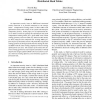Free Online Productivity Tools
i2Speak
i2Symbol
i2OCR
iTex2Img
iWeb2Print
iWeb2Shot
i2Type
iPdf2Split
iPdf2Merge
i2Bopomofo
i2Arabic
i2Style
i2Image
i2PDF
iLatex2Rtf
Sci2ools
P2P
2007
IEEE
2007
IEEE
An Information-Theoretic Framework for Analyzing Leak of Privacy in Distributed Hash Tables
An important security issue in DHT-based structured overlay networks is to provide anonymity to the storage nodes. Compromised routing tables in those DHTs leak information about other nodes in the system and therefore compromise privacy. In this paper, we use information theory to build a model to quantify the information leak from compromised routing tables for a given DHT with certain routing geometry and route table size. Based on this model, we have analyzed and compared how existing DHTs perform in face of anonymity attacks. We found that ring-based routing geometry (Chord) performs the best among the studied DHTs with the same routing complexity when no routing optimizations are used. The analysis of the interaction between routing geometries and recipient anonymity will help improve the design of future DHTs which can achieve a balance between routing efficiency and robustness against information leak.
| Added | 04 Jun 2010 |
| Updated | 04 Jun 2010 |
| Type | Conference |
| Year | 2007 |
| Where | P2P |
| Authors | Souvik Ray, Zhao Zhang |
Comments (0)

